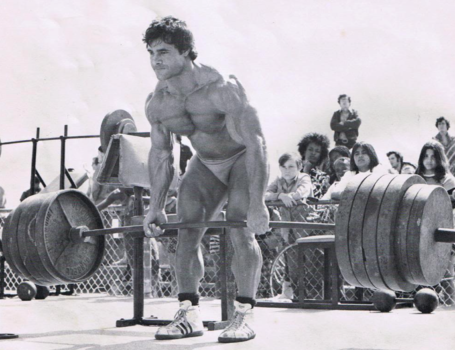If you want to get smart, the question you have to keep asking is “why, why, why?”
– Charlie Munger

If we want extraordinary results, we must have extraordinary focus.
To bodybuild, you should train specifically, not assuming general strength or athletic programs will somehow lead to great results.
A good bodybuilding plan is holistic. An exercise involving lots of muscle isn’t valuable by default… we must contemplate next-order consequences so that it fits alongside others.
The squat, often called the king of exercises, is not efficient for bodybuilding.
While squatting certainly involves many muscles at once and is tolerated well at least by the knees, it doesn’t train the rectus femoris of the quads (due to concurrency). You’d need to include a sissy squat or leg extension as well.
Enter the stiff-legged dead-lift: true king of bodybuilding exercises. However, this isn’t because it works tremendous muscle at once, though it does throughout the entire posterior chain… it’s due to reducing exercises needed for a complete program.
It addresses the hip extensors, including the glutes & hamstrings. Pure hip extension, with little bending at the knees, emphasizes the biceps femoris long head & semimembranosus. This also replaces the need for another hip extension movement like squats or leg presses.
Whole rear upper body thickness is hit to contribute to and stabilize the movement. This includes the lower back (erector spinae), upper lats, trapezius complex, rear deltoids and rotator cuff (infraspinatus & teres minor) muscles. It replaces back extensions and T-bar, bent-over or cable rows.
Many pulling movements for the back involve elbow flexion, which can overburden the brachialis & brachioradialis. Curls, pull-ups & rows all work them. Dead-lifts allow you to hit the entire back without involving the elbows again.
Even the calves get stimulated, though likely not enough to replace heel raises.
So not only do you hit at least several major regions of the body, you no longer need several bodybuilding exercises as well.
Stiff-Legged Dead-Lift Tips
This routine helped me grow… I incorporated one (modified) power lifting movement into each workout… On day one it was the wide grip deadlift using straps (regular grip).
– Frank Zane
Fix the knees with a slight bend.
As I define it, the stiff-legged deadlift is the same as the Romanian Dead-Lift (RDL). Whether you set the weights down or keep constant tension over less range of motion, it doesn’t matter.
The essential feature is the knees kept at a near-constant angle during the movement. This won’t be perfect. Yet as mentioned, this uniquely hits the hamstrings.
It also still has the other benefits of dead-lifting instead of minimal quad involvement, from bending the knees, for more weight alone.
Avoid deficit dead-lifts; do rack pulls.
Extreme ranges of motion on dead-lifts get accomplished from excessive flexion in the lumbar region.
Many trainees flex the spine greatly to lift the barbell or trap/hex bar from the floor, even with 45 lb. plates elevating it, and certainly when standing on a platform.
The bottom of this range is a vulnerable position as well, unlike on a hyperextension. The weight is furthest away from your body while the hamstrings are stretched. This can lead to a muscle tear if not careful!
Instead, try rack pulls where you place the barbell across bars, usually on a half or power rack, or upon large boxes.
Try beginning the dead-lift somewhere just below the knees at shin level, allowing an effective range of motion without jeopardizing your safety. You can then stand on a platform to finetune the range of motion.
Use straps.
An over-under, hook or snatch grip is unnecessary and potentially dangerous.
By using straps, you can reasonably adopt a double-overhand grip, which improves safety for the distal biceps tendon at the elbow.
This also overloads the forearm flexors, due to still holding most of the weight, probably eliminating the need for specific forearm work through wrist curls.
Don’t lean back at the top.
Many trainees lean back perhaps to get that feeling of dominating the movement. This is unnecessary and technically an unloaded position since you no longer oppose gravity. Standing upright is sufficient.
Avoid odd variations.
Zercher, sumo-style or other unusual forms have no bodybuilding value.
Though uncommon today, you don’t need to elevate your toes on a 2×2 block to hit the hamstrings better, which feels awkward too.
Shoe choice isn’t too important, but flat soles are generally best for lower body work. They enhance stability without raised heels, which can irritate the knees through greater range of motion than attainable otherwise.
Remember, placing your body in weird positions risks your safety!
The Stiff-Legged Deadlift: An Efficient Possibility
While incredibly efficient, stiff-legged dead-lifts are not magical.
No exercise, tool, or even method is special from a bodybuilding perspective.
We just need to progressively overload the right muscles, applying however much work is needed, while recovering to get better over time.
With exercise selection, you could perform a hyperextension for the lower body and a horizontal row for the upper body, to achieve a similar effect.
Dead-lifts can be challenging to integrate within a split routine. They work both upper & lower body muscles intensely. Therefore, I like to perform them at the end of the week, with cardio & rest on the days before and after.
I balance out dead-lifts with decline sit-ups for closed-chain hip & trunk flexion, plus bench pressing aligned with the middle chest (above the nipples) for upper body front thickness.
Consider the stiff-legged dead-lift for your bodybuilding routine, benefiting from its efficiency, so long as it suits your capabilities & preferences!
